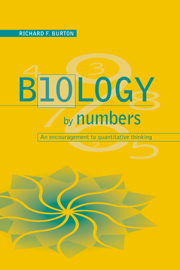Book contents
- Frontmatter
- Contents
- Preface
- A guide to the book
- 1 Putting two and two together
- 2 Units, formulae and the use of old envelopes: confronting some obstacles to quantitative thinking
- 3 Aspects of energy metabolism
- 4 Getting things in proportion
- 5 Perilous percentages, dangerous ratios
- 6 Building a trophic pyramid
- 7 Sodium in animals and plants
- 8 Exchanges of water and carbon dioxide
- 9 A geometric series
- 10 Introduction to logarithms
- 11 Bringing logarithms to life
- 12 Exponential relationships
- 13 Aspects of allometry
- 14 More on allometry, and on quantitative patterns in nature
- 15 How the abundance of food affects rates of feeding
- 16 The characterization of trees and other branching systems
- 17 Epilogue
- References
- Notes
- Index
5 - Perilous percentages, dangerous ratios
Published online by Cambridge University Press: 05 June 2012
- Frontmatter
- Contents
- Preface
- A guide to the book
- 1 Putting two and two together
- 2 Units, formulae and the use of old envelopes: confronting some obstacles to quantitative thinking
- 3 Aspects of energy metabolism
- 4 Getting things in proportion
- 5 Perilous percentages, dangerous ratios
- 6 Building a trophic pyramid
- 7 Sodium in animals and plants
- 8 Exchanges of water and carbon dioxide
- 9 A geometric series
- 10 Introduction to logarithms
- 11 Bringing logarithms to life
- 12 Exponential relationships
- 13 Aspects of allometry
- 14 More on allometry, and on quantitative patterns in nature
- 15 How the abundance of food affects rates of feeding
- 16 The characterization of trees and other branching systems
- 17 Epilogue
- References
- Notes
- Index
Summary
Some general points
I was surprised when I first heard an intelligent student confess to difficulties with percentages, for we all meet them daily. And yet there are pitfalls. You hear on the radio that X has increased this year by 500% and of course you know that X has increased sixfold – or do you harbour suspicions that Xactually increased fivefold and that the speaker has forgotten to subtract 100? Try asking a friend the following question: if a quantity increases by 50% and then decreases by 50%, what is the net effect? I discuss here some specific points of difficulty arising from properties of this particular mathematical function, and also problems associated with ratios. Most of the points to do with percentages apply equally to decimal fractions, for percentages are but these multiplied by 100.
Of course there are simple advantages in expressing fractions as percentages, for by expressing 0.69 as 69%, for example, one deals with a whole number. Also, it is slightly easier to say that dicotyledons make up 69% of the species of higher plants than to express the same thing in terms of the decimal fraction. It is convenient, moreover, if one can say, for example, that the human body consists of 60% water, without having to specify what the rest is.
A more fundamental issue arises in dealing with variable quantities, for it is often unappreciated that ‘percentage’ (or fraction) is not a linear function of the quantity that is likely to be of primary interest.
- Type
- Chapter
- Information
- Biology by NumbersAn Encouragement to Quantitative Thinking, pp. 61 - 68Publisher: Cambridge University PressPrint publication year: 1998



